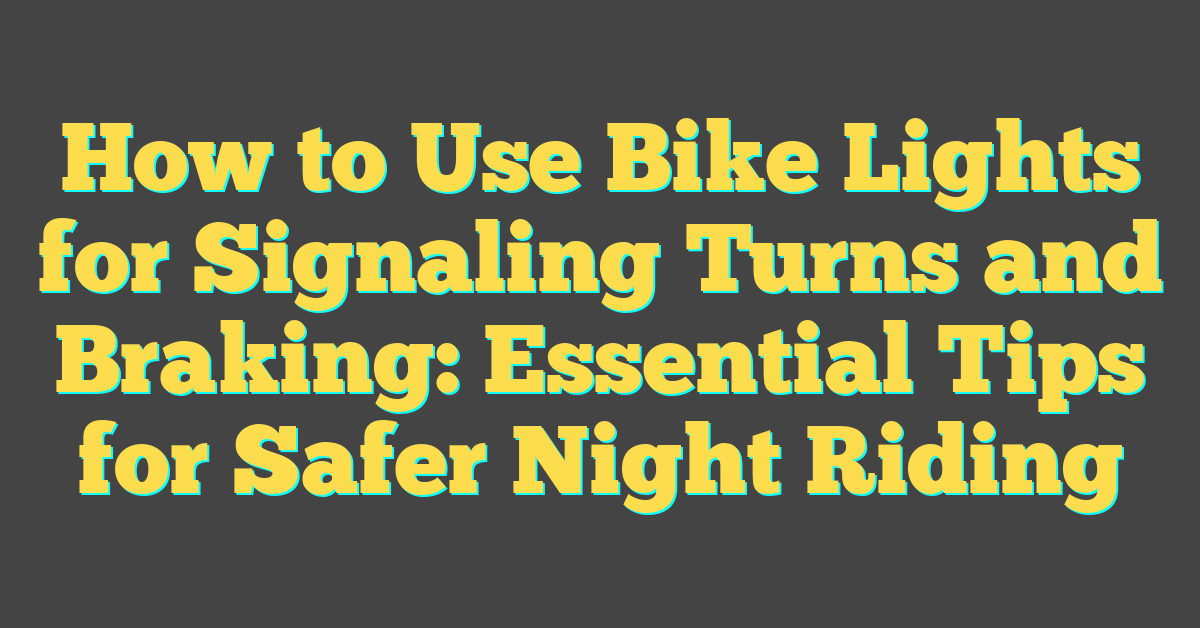Riding a bike at night or in low-light conditions can be a thrilling experience, but it also comes with its challenges. One of the most important things I’ve learned is how crucial it is to communicate my movements to drivers and other cyclists. That’s where bike lights come in—not just for visibility, but for signaling turns and braking too.

Using bike lights effectively isn’t just about strapping them on and hoping for the best. It’s about understanding how to use them to keep yourself and others safe. Whether you’re navigating busy streets or cruising quiet trails, mastering this skill can make all the difference. Let’s dive into how these small but mighty tools can transform your ride into a safer, more confident experience.
Importance Of Bike Lights For Safety
Bike lights aren’t just accessories; they’re fundamental safety tools. They make cyclists visible to drivers, pedestrians, and other riders, reducing the risk of accidents. When riding at night or in foggy conditions, front and rear lights ensure you’re seen from a distance, giving others enough time to react.
Using well-positioned lights enhances communication on the road. A flashing rear light can alert drivers following behind, while a steady front light helps illuminate your path and signals your presence. This added visibility becomes crucial during busy traffic or dimly lit routes.
The safety benefits go beyond visibility. Lights designed for signaling turns or braking let riders warn others of their intentions. For instance, a brake light that activates when you slow down is particularly helpful in group rides or busy intersections, where sudden stops can lead to collisions.
Investing in quality bike lights creates a more predictable and secure riding environment. Look for options with reliable battery life, weather resistance, and adjustable brightness. Properly maintained lights, whether rechargeables or those with replaceable batteries, work consistently when needed.
Types Of Bike Lights For Signaling
Signaling lights for bikes enhance communication with other road users and make cycling safer. Selecting the right type depends on your specific needs and riding conditions.
Turn Signal Lights
Turn signal lights indicate directional changes, making your intentions clear to others. These typically attach to handlebars or rear racks and emit flashing or directional arrows. Wireless turn signals are a popular choice, as they link to a remote on the handlebars for easy operation. For example, I’ve found models with amber LEDs to be highly visible, even during the day. When riding in traffic or with groups, turn signals reduce confusion and improve predictability.
Brake Lights
Brake lights activate when you stop or slow down, warning others of your reduced speed. Many modern versions use motion sensors to detect braking automatically, eliminating the need for manual input. These lights often mount under the seat or on the rear fender. Some designs include ultra-bright red LEDs for visibility in various lighting conditions. On rides through busy intersections, brake lights have been invaluable for preventing sudden collisions.
Combination Lights
Combination lights integrate turn signals and brake lights into a single unit, streamlining your bike’s setup. These systems are convenient and reduce the number of separate attachments. I’ve noticed that rechargeable models with USB ports are especially efficient, as they offer versatility and long-lasting performance. When space or handlebar clutter is an issue, combination lights provide a practical all-in-one solution.
Setting Up Your Bike Lights
Properly setting up bike lights ensures they function effectively for signaling. Preparing the lights, position, and mounting correctly enhances safety and communication on the road.
Installing Turn Signal Lights
Mount the lights on the handlebars for visibility from the front and rear. For rear-mounted turn lights, align them with the back rack or seat post. Ensure the wiring, if present, stays secure and doesn’t interfere with the wheels or braking system.
Test visibility during installation by sitting on the bike and activating the signals. Adjust angles where necessary to optimize their visibility at different heights and distances. For remote-operated turn lights, position the control within easy reach on the handlebars to reduce distractions while riding.
Installing Brake Lights
Install brake lights on the seat post or rear rack, as they must face traffic directly behind you. Devices with motion-sensing brake lights simplify the setup since they don’t require manual activation. Position them securely to withstand vibrations and uneven terrain without shifting.
After mounting, test their responsiveness by simulating braking movements. Adjust brightness settings according to local traffic conditions, ensuring they’re bright enough to alert others without being excessively glaring.
How To Use Bike Lights For Signaling Turns
« The Aesthetics of Bicycle Lighting: Design Trends Revolutionizing Style and Safety on Two Wheels
Bicycle Lighting for Delivery and Courier Services: Top Picks and Safety Tips You Need to Know »
Using bike lights for signaling turns increases safety and makes communication with drivers and other cyclists much clearer. I’ve spent years setting up my bike lights to ensure they’re effective, so I’ll share key tips on getting the most from your turn signals.
Activating Turn Signals
Turn signals on bikes typically involve LED units mounted on handlebars or rear racks. To activate them, most models use a remote control or button conveniently placed near your handlebars. I always check that the remote is within easy reach, so I don’t risk losing control of my bike.
After installation, test the functionality of each signal. Flash the left signal, then the right, and make sure they’re bright enough in your riding conditions. It’s best to test them during both daylight and nighttime to see how they perform. I recommend turning on your signals several seconds before approaching an intersection or making a turn; this provides enough time for others to react.
Hand Signals Vs. Light Signals
Hand signals are the traditional way to indicate turns while biking, but they’re not always visible in low-light or high-traffic situations. That’s why I rely on turn-signal lights when riding in the evening or on busy roads. Using bike lights for signaling frees up your hands, letting you maintain proper control over your handlebars.
Many turn-signal lights include arrow-shaped indicators for clearer communication, which I find incredibly helpful. Combining hand signals with light signals works well if one is more visible than the other. For example, I use hand signals during the day for extra clarity and keep the lights active as a backup in case drivers don’t notice the hand gesture.
How To Use Bike Lights For Braking
Using brake lights while riding improves safety, especially in traffic or crowded conditions. These lights clearly signal when you’re slowing down, helping others anticipate your movements.
Activating Brake Lights
Brake lights activate either manually or through motion-sensing features, depending on their design. Many modern brake lights come equipped with built-in sensors that detect when you decelerate and automatically illuminate. For manual models, a switch connects to your braking system, requiring a slight press to trigger the light.
To ensure proper use, I recommend testing brake lights after installation. Position them securely on your seat post or rear rack so they’re clearly visible from behind. If your light has brightness settings, choose a medium to high setting for daytime visibility, and adjust only as needed for night rides.
Synchronizing With Your Braking
Accurately synching bike lights with your braking ensures the lights activate at the precise moment you decelerate. Motion-sensing models usually handle this automatically, providing uninterrupted signaling. In manually controlled setups, test the timing by engaging the brake and observing the light’s response.
If your motion-sensing brake light is delayed or inconsistent, recheck the mounting angle and ensure the sensor isn’t obstructed. On manual lights, confirm all connections align correctly with the brake lever to minimize response lag. Regular checks help maintain synchronization, especially after maintenance or adjustments.
Tips For Effective Bike Light Usage
Position lights strategically to maximize visibility. Mount front lights on handlebars to ensure a clear path ahead and alert oncoming traffic. Place rear lights on the seat post or rear rack to signal to vehicles behind you. For turn signal and brake lights, check that they’re aligned properly to be visible without obstruction, even in dense traffic.
Use consistent settings based on conditions. In busy areas, flashing modes for rear lights grab attention effectively, while steady beams work better in low-visibility environments like foggy or dark roads. Adjust brightness to ensure lights aren’t too dim for others to see or too bright to blind drivers.
Check light functionality regularly. Before every ride, test each light to confirm proper operation. Activate turn signals, test brake lights’ responsiveness, and inspect general visibility. Replace batteries or charge lights as needed to avoid failures during a ride.
Combine light signals with hand gestures where possible. Though turn signal lights communicate effectively, using hand signals as a back-up adds a layer of clarity. This is especially important during daylight or when interacting with other cyclists who may expect traditional cues.
Invest in quality lights with diverse features. Look for weather-resistant, durable options with long battery life and easy recharging. Lights with motion-sensing technology for braking or multi-mode signals enhance safety by offering better functionality. Reliable products ensure consistent performance in various conditions.
Keep lights clean and unobstructed. Dirt, mud, or grime can block light output, reducing effectiveness. Wipe down lenses and check for scratches that might diffuse light unevenly. Regular maintenance extends the lifespan of your gear and ensures maximum visibility while riding.
Conclusion
Using bike lights for signaling turns and braking is a simple yet powerful way to stay safe and communicate clearly on the road. They not only make you more visible but also help others anticipate your movements, which is crucial in traffic or group rides.
By investing in quality lights and setting them up properly, you can ride with confidence and peace of mind, knowing you’re doing your part to create a safer environment for everyone. So, light up your ride, stay visible, and enjoy the journey!




